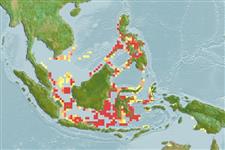Teleostei (teleosts) >
Blenniiformes (Blennies) >
Blenniidae (Combtooth blennies) > Salariinae
Etymology: Ecsenius: Greek, exenios, -os, -on = uncontrolled, immoderate; ops: Name from the Greek word meaning eye, refers to the dark spot on the dorsoposterior margin of the orbit; noun in apposition.
Environment: milieu / climate zone / depth range / distribution range
Ecology
Marine; demersal; depth range 4 - 20 m (Ref. 48636). Tropical
Western Central Pacific: Indonesia.
Size / Weight / Age
Maturity: Lm ? range ? - ? cm
Max length : 5.5 cm TL male/unsexed; (Ref. 48636)
Short description
Identification keys | Morphology | Morphometrics
Diagnosis: a black outer ring surrounding a bright yellow ring in iris of the eye; faint to bright white stripe originating on snout below ventro-anterior margin of orbit and continuing posteriorly along ventral margin of orbit to preopercular series of pores, ending or continuing much diminished in intensity to posterior margin of opercle; pale-margined, dark spot, smaller than pupil of eye, present on post-orbital margin at about 2 o'clock position. Body more or less uniformly olive-brown or with the indications of fine, greenish yellow, stripe-like area along dorsal body contour below dorsal fin, paralleled ventrally by broad, olive-brown area grading ventrally and narrowly to greenish yellow at body midline, then abruptly whitish below (Ref. 55736).
Body shape (shape guide): elongated.
Adults are found in clear coastal to outer reef habitats to about 20 m depth (Ref. 48636), perched on live corals in sheltered reefs (Ref. 90102). Oviparous. Eggs are demersal and adhesive (Ref. 205), and are attached to the substrate via a filamentous, adhesive pad or pedestal (Ref. 94114). Larvae are planktonic, often found in shallow, coastal waters (Ref. 94114).
Life cycle and mating behavior
Maturity | Reproduction | Spawning | Eggs | Fecundity | Larvae
Oviparous, distinct pairing (Ref. 205).
Springer, V.G. and G.R. Allen, 2001. Ecsenius ops, from Indonesia, and E. tricolor, from western Philippines and northwestern Kalimantan, new species of blenniid fishes in the stigmatura species group. aqua, J. Ichthyol. Aquat. Biol. 4(4):151-160. (Ref. 55736)
IUCN Red List Status (Ref. 130435: Version 2025-1)
Threat to humans
Harmless
Human uses
Tools
Special reports
Download XML
Internet sources
Estimates based on models
Phylogenetic diversity index (Ref.
82804): PD
50 = 0.5000 [Uniqueness, from 0.5 = low to 2.0 = high].
Bayesian length-weight: a=0.00776 (0.00356 - 0.01695), b=3.00 (2.81 - 3.19), in cm total length, based on LWR estimates for this (Sub)family-body shape (Ref.
93245).
Trophic level (Ref.
69278): 2.0 ±0.00 se; based on food items.
Resilience (Ref.
120179): High, minimum population doubling time less than 15 months (Preliminary K or Fecundity.).
Fishing Vulnerability (Ref.
59153): Low vulnerability (10 of 100).
🛈
Nutrients (Ref.
124155): Calcium = 666 [386, 1,600] mg/100g; Iron = 2.12 [1.19, 3.96] mg/100g; Protein = 17 [16, 18] %; Omega3 = 0.148 [0.072, 0.308] g/100g; Selenium = 40.5 [18.2, 100.9] μg/100g; VitaminA = 29.8 [7.7, 116.2] μg/100g; Zinc = 3.36 [2.20, 5.04] mg/100g (wet weight);
